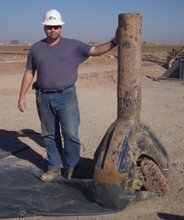
Seems two of the most important things in my job are nipples and bits, pipe nipples and rock bits that is. I use a pile of nipples to connect different sensors (mostly pressure transducers) to different parts of the drill rig to measure all sorts of parameters for the log. As to bits, I don't directly interface with them, just what they produce.
The first pic is a 3.75" drill bit I was given, next to it is a 1/2", sch 40 pipe nipple, 6" long, that will give scale to all the other pics of drill bits, several different sizes of drill bits are used to drill a well. Most people do not realize that a well is not one size, all the way down, as drilling proceeds, different parts of the well have to be sealed off from others, to prevent the migration of fluids, and to provide integrity to the well wall, to help prevent it collapsing in behind the drill bit, at different depths, different weights of drilling mud are needed to keep fluids down in the hole, and too much pressure differential from one part of the hole to another can cause all kinds of headaches (and cost all kinds of $$$), hence, at the surface, most geothermal wells start as a 36" hole for about the first 100 feet, into this, the conductor, a 30" diam pipe is cemented into place.

After the cement is cured, a 26" hole is drilled, with a 20" casing cemented into place(300-600').

Out of the bottom of the 20", a 17.5" hole is drilled to a depth of 600-2000', and a 13.375" casing is cemented in place.

(this pic is of 17.5 and 12.25 bits)
A 12.25 hole is drilled is drilled as deep as 6000 or so feet, with a 9.625 casing.

Misc pics:

Different teeth are needed for different kind of rocks, soft rocks (shale, limestone, sandstone (most sandstones that is) enjoy the ministrations of a wide chisel tooth of a mill tooth bit, knocking out large chunks, and often drilling rapidly down (PDC bits are for a later date). The carbide button tooth is used for hard rocks, like granite, basalts, gneisses, quartzites, and quartz cemented sandstones (near quartzite).
The following pic is of a carbide button chisel tooth bit, well worn, the rounded nubs of carbide used to terminate in a chisel like tooth, this one has seen a lot of hours making lots of hole.

Contrary to popular belief, all of these bits (tri-cone roller bits) do not scrape the rock away, instead, a lot of force is used, pushing down on the bit, as the cones roll around in a circle, an immense amount of force is concentrated at the tip of the tooth as it rolls over the rock, this action simply pops a little chuck of rock out of the drilling surface, much like dropping something heavy on concrete will do, but this action is performed over and over and over, with drilling mud picking up these fragments and carrying them to the surface, for me to collect, study, analyze, classify, and document.
EDIT: the depths listed are just a generality, and for some wells, may be off by a factor of x2, also, deeper wells continue the theme of getting smaller in diam, the next stage is a 8.5" bit with 7" casing and so on add nauseum.....



No comments:
Post a Comment